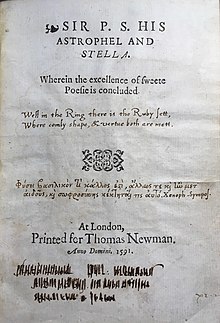Astrophel and Stella

Probably composed in the 1580s,
Some have suggested that the love represented in the sequence may be a literal one as Sidney evidently connects Astrophil to himself and Stella to Lady Penelope, thought to be
Publishing history

Many of the poems were circulated in manuscript form before the first edition was printed by Thomas Newman in 1591, five years after Sidney's death. This edition included ten of Sidney's songs, a preface by
A copy of the original manuscript, made by Sir Edward Dymoke, has been held by the University of Edinburgh Library since the 1620s.
Astrophel vs. Astrophil
The Oxford University Press collection of Sidney's major works has this to say about the title:
There is no evidence that the title is authorial. It derives from the first printed text, the unauthorized quarto edition published by Thomas Newman (1591). Newman may also have been responsible for the consistent practice in early printings of calling the lover persona 'Astrophel'. Ringler emended to 'Astrophil' on the grounds of etymological correctness, since the name is presumably based on the Greek aster philein, and means 'lover of a star' (with Stella meaning 'star'); the 'Phil' element alluding also, no doubt, to Sidney's Christian name.[5]
Musical settings
- Three of the ten sonnets have settings for voice with bass and lute accompaniment in A Musical Banquet, 1610, published by Robert Dowland. The eighth sonnet, In a Grove Most Rich of Shade, is set by Charles Tessier. The ninth sonnet, Goe my Flocke, and the tenth sonnet, O Deere Life when shall it be, are anonymous settings. The second sonnet, Have I caught my Heavenly Jewel, was set anonymously for lute and voice in British Library Add. MS 15117, c.1614-1630.
Further reading
- MacArthur, J., Critical Contexts of Sidney's Astrophil and Stella, and Spenser's Amoretti (Victoria: University of Victoria Press, 1989). ISBN 0-920604-45-5
- Parker, Tom W.N, Proportional Form in the Sonnets of the Sidney Circle (Oxford: Clarendon Press, 1998).
- Young, R.B., Three Studies in the Renaissance: Sidney, Jonson, Milton (New Haven: Yale University Press, 1958).
See also
- Philip Sidney
- Sonnet
- Sonnet sequence
- English Renaissance
- 1591 in poetry, the year of the first edition
- 1598 in poetry, the year of the more authoritative, revised edition
References
- ^ Cooper, Sherod M., The Sonnets of Astrophil and Stella: A Stylistic Study (The Hague: Mouton, 1968), 64.
- ^ Renaissance Literature: An Anthology edited by Michael Payne and John Hunter (London: Blackwell, 2003), 500.
- ^ a b Sir Philip Sidney, 168-9.
- ^ Sir Philip Sidney, 168.
- ^ Duncan-Jones, Katherine, ed., Sir Philip Sidney: The Major Works including "Astrophil and Stella" (Oxford: Oxford University Press, 1989), 357
External links
- Astrophil and Stella (Gutenberg)
 Astrophil and Stella public domain audiobook at LibriVox
Astrophil and Stella public domain audiobook at LibriVox- Astrophil and Stella Study Guide & Essays
- Wikidata
